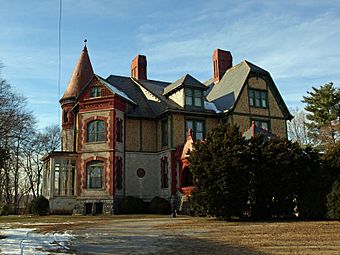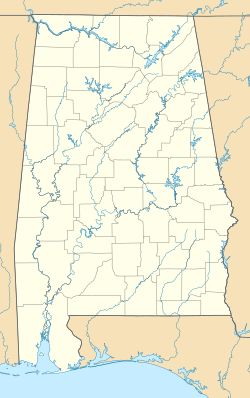Kildare–McCormick House facts for kids
Quick facts for kids |
|
|
Kildare–McCormick House
|
|

The house in December 2010
|
|
| Location | 2005 Kildare St., Huntsville, Alabama |
|---|---|
| Area | 1.1 acres (0.45 ha) |
| Built | 1886–87 |
| Architectural style | Queen Anne |
| NRHP reference No. | 82002051 |
| Added to NRHP | July 15, 1982 |
The Kildare–McCormick House is a beautiful old home in Huntsville, Alabama. It was built a long time ago, between 1886 and 1887. This house is famous for its fancy and detailed Queen Anne style of architecture.
The first owners of the house helped Huntsville grow a lot. They started new businesses and also helped people in the community. This special house was added to the National Register of Historic Places in 1982. This means it's an important historical building.
Contents
History of the Kildare–McCormick House
Who Built the House?
The Kildare–McCormick House was built by a man named Michael O'Shaugnessey. He was an industrialist, which means he started and ran big factories. Michael came to Huntsville from Nashville in 1881. He and his brother opened a factory that made oil from cottonseed.
Michael also belonged to a group called the North Alabama Improvement Company. This group invested in important things like roads, bridges, and factories. They were a big part of building the Dallas Mill, a large factory in the area.
Naming the House
Michael O'Shaugnessey built his large home in 1886. It sat on a big piece of land, about 71 acres. He named his new house "Kildare" after the county in Ireland where he was born.
The McCormick Family's Time
In 1900, Michael O'Shaugnessey moved back to Nashville. He sold the house to Mary Virginia McCormick. Her father, Cyrus McCormick, was also a very successful industrialist. He invented the mechanical reaper, a machine that helped farmers harvest crops much faster.
Virginia McCormick used the Kildare house as her winter home. She lived there with her caretaker, Grace Walker. Virginia and Grace were very involved in helping the community. They did a lot of philanthropic efforts, which means they gave money and time to good causes.
Helping the Community
Virginia McCormick helped fund several YMCAs in the factory towns around Huntsville. She also paid for a special wing for African-American patients at the Huntsville Hospital. She even helped build a hospital at Alabama A&M University. Another relative, Robert R. McCormick, also helped fund a building at Alabama A&M.
The house was a busy place for social events. Virginia McCormick hosted many parties, including Christmas parties for children. There were also Easter egg hunts and a big celebration for Virginia's birthday in May. During her time, a sunny room called a conservatory was added next to the ballroom. A porch was also built at the back of the house.
Later Years and Restoration
Virginia McCormick moved out of the house in 1931. The family then divided and sold the property the next year. For the next 40 years, the house had many different owners. It was used as a hotel, a boarding house, a health spa, and even an antique shop.
After many years of not being taken care of, the house was bought by James Reeves in 1975. He spent the next 20 years carefully restoring the house to its original beauty. The current owners bought the house in 2007.
Architecture of the Kildare–McCormick House
How Big is the House?
The Kildare–McCormick House is very large. It has three main floors, plus a lower level called an English basement. Inside, there are 40 rooms and about 17,000 square feet of living space.
The house has a main central part. It also has a wing on the south side with a rectangular section and a round tower. Another wing on the northwest side has a curved section. The house is designed in a very decorative Queen Anne style. Its outside walls use many different materials and colors.
Outside Details
The basement and first floor are covered in limestone blocks. The first floor's limestone is smoother than the basement's. Red brick is used for the corners, called quoins, and around the windows. The third floor of the tower is also made of red brick.
The triangular part of the roof, called a gable, on the southeast side has a small window. It also has a fancy terra cotta relief, which is a sculpture that sticks out from the wall. The upper floors of the house are covered with tan river stones. These stones are separated into panels with green-painted wood.
Windows and Roof
Most windows on the first floor are simple one-over-one sashes. Some have narrow side windows, called sidelights. Others have stained glass or leaded glass panels above them, called transoms. On the second floor of the main part of the house, the windows have a row of small panes around the upper part. The third floor windows have the entire upper sash made of small panes.
The roof is made of slate and has an unusual shape. It has many gables and windows that stick out, called dormers. There are also four brick chimneys. These chimneys have special designs and tapered tops. Wooden brackets stick out from under the roof edges, called eaves.
Porches and Entrances
A flat-roofed porch stretches across the front of the house. The northern part of this porch has wooden posts and a short railing. The part over the main entrance has a limestone wall on one end. It also has an arched opening framed with terra cotta. This part of the porch has a fancy hipped roof and a decorative top piece called a finial.
A special covered entrance for carriages, called a porte-cochère, extends from the porch. It has a pyramid-shaped roof with terra cotta ridges and a finial. This covers the curved driveway.
Inside the House
When you enter the main door, you step into a hall with a stairway. To the right, there are doors to two living rooms, called parlors. The dining room is at the back of the house. To the south, there is a large ballroom. The ballroom includes the southeastern bay and tower. It also opens into the conservatory, which was added later.
Behind the dining room, there is a porch and a breakfast room. The northwestern wing of the house holds the butler's pantry. This is a small room used for serving food. There are also stairs down to the kitchen in the basement, a bathroom, and the library in this wing.
The second floor has a large hall and seven bedrooms. The third floor has its own set of stairs from the second floor hall. It contains four more bedrooms and a billiard room, where people can play pool.



